Architectural Splendor in Citrus Country
Photos: Kip Miller
"Wow!
Have a look! Why has it taken us so long to come here?" I query my
husband as we pull into the valet parking of the Inn. While we have been
aware of this unique hostelry for decades, we always headed to Palm Springs
whenever venturing inland from LA, never once opting to experience this
icon of history commanding an entire city block. Truth be told, The Mission
Inn and Spa is an architectural landmark unlike any other in America,
built in stages, and rivaling resorts such as The Broadmoor in Colorado
Springs and The Greenbrier in West Virginia.
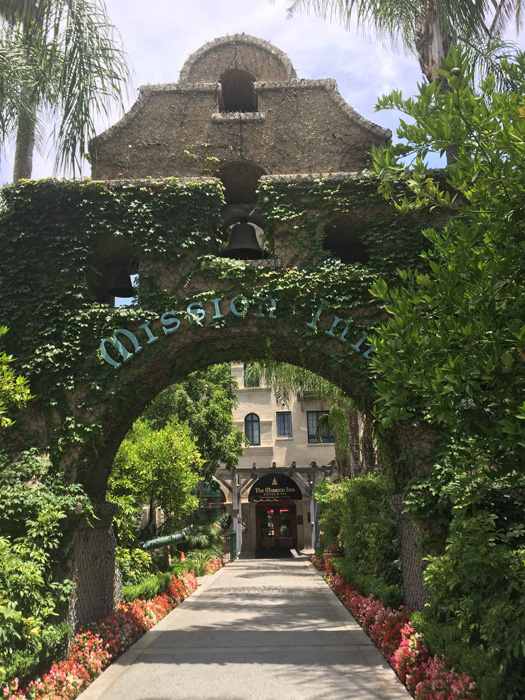
The Inn's bell gateway is a copy of the San Gabriel Mission belfry.
A collection of 800 bells were once scattered throughout the premises.
A valet whisks our car away as we wheel our bags through the property's bell tower gateway, a copy of the San Gabriel Mission belfry, our eyes darting every which way. The hotel is so huge that you can only take in a portion of the site at a time. A lushly planted approach is bursting with begonias and tropical plants. On our right an enormous Asian bell from Nanking, cast during the time of The Boxer Rebellion, is just one of nearly 800 bells collected by Miller during his frequent overseas shopping forays. It borders Las Campanas, the property's outdoor Mexican restaurant and cantina tucked under shady umbrellas and palms. I turn my head to the left to admire two enormous bronze Spanish cannons that Miller, a consummate collector, had shipped in from a trade show in San Francisco. Near the entrance, an area known as the court of the Birds, a huge birdcage houses two colorful macaws emitting ear-splitting squawks and occasional recognizable words. "Miller was a cool character. He was really into birds and he loved his two pet macaws that he named Napoleon and Joseph," says a gray-haired matron standing next to me. "In the old days they had complete run of the place. Of course, their wings were clipped. These two birds arrived when the hotel was refurbished."
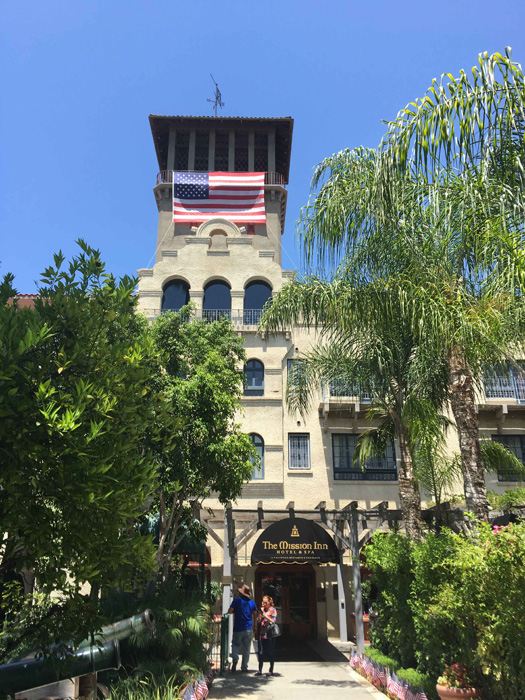
The front entrance area, part of The Court of the Birds, features a huge cage housing two resident macaws.
The lobby area exudes both comfort and grandeur, with plush seating and eye-popping antiques. We survey its magnificent floors and wood beams and wander toward the Presidential Lounge on the right. Oil paintings of ten U.S. presidents adorn its outer wall. Originally the space was an enormous suite for visiting presidents and heads of state. Today it functions as a piano bar and lounge. A portrait of Nixon notes that he and his wife Pat were married here; another of Reagan that he spent his honeymoon at the Inn. I linger in front of Teddy Roosevelt's portrait. "Roosevelt replanted the first navel tree in Riverside here at the Inn," says a passing waiter on his way to the lounge. "Riverside's two original navel trees came here from Brazil." We admire an oversized wood chair that was custom made for President Taft in 1909 as a gift honoring his visit to the Inn. "Taft was a huge man. He probably weighed in at about 350 pounds," my husband remarks. Sensitive about his girth, Taft was insulted by the enormity of the chair and refused to take it back to Washington. Today it is one of the Inn's prized artifacts, sat on by thousands of visitors.
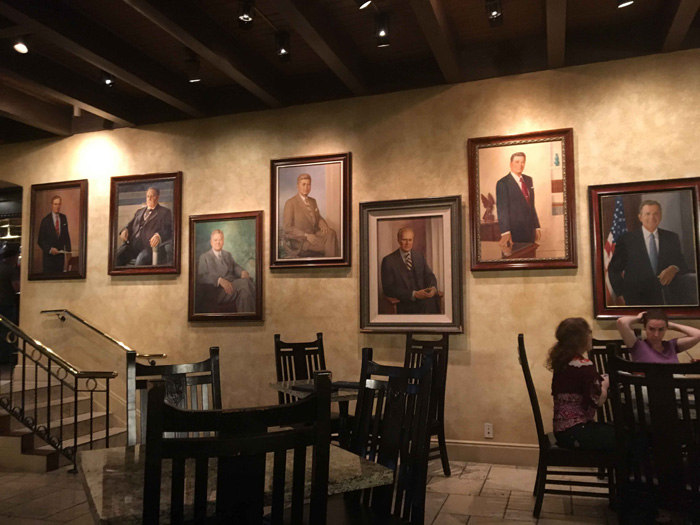
Portraits of ten U.S. presidents adorn the facade of The Presidential Lounge, once the grand quarters for visiting heads of state.
"Welcome to The Mission Inn," chirps a young woman at the reception
desk. "Is this your first time here?" "Yes, but definitely
not the last," I respond. "Wow, you two locked in the bargain
mid-week rate," she notes. "That's because of the Fourth holiday
this week. Be sure to take the elevator to the top floor and walk out
to the rooftop. There's a lot to see up there." Our first floor room,
located at the edge of the Cloister Wing, is airy, bright and distinguished
by sculptural niches. We are thrilled by its quiet location. Apparently
no two rooms at the Inn are alike, and each includes some original architectural
elements without forsaking modern amenities. I stroke the linens on the
bed. "These could be the softest sheets I have ever had at a hotel,"
I murmur, "at least 650 threads, I bet." The bathroom is well-stocked
with toiletries from Kelly's Tuscan Spa, a luxurious facility added to
the Inn in 2004. We unpack and take a brief, restorative nap. "I
can't wait to explore!" says my husband with anticipation.
But navigating The Mission Inn can be daunting. To do it properly, we decide that a little background reading is in order. We are filled with questions. "When did the Mission Inn become so famous for its architecture?" my husband ponders. "And how did it expand over the years to cover an entire city block?" I am curious to find out which California missions served as inspiration for the architects who worked on it. We are anxious to start, but head first to Las Campanas for a light lunch. It's a mild afternoon, and under our shady umbrella, my tostada salad is tangy and refreshing. "All our sauces are made in-house," the waiter brags. Indeed, our selections are delicately nuanced, the best Mexican fare we have had in years. Minutes later we take the elevator to the Inn rooftop to stroll through its assemblage of towers, arches, hidden patios, and water features, framed by vistas of downtown Riverside and Mount Rubidoux in the distance. The oldest part of the hotel is the Mission Wing, a U-shaped complex that includes a major portion of the Inn's rooms, the lobby, spa lounge and most of the restaurant areas. Designed by architect Arthur Benton, it was completed in 1902. Next comes the 1910 Cloister Wing, also built by Benton and featuring its largest public space, stained glass windows and balconies. This wing evokes several California Missions, most notably its large red dome that towers above Orange Street below. "It's going to take a few more visits before we can nail down this place," says my husband as we try to make sense out of an array of turrets, decorative pools, walkways and staircases that comprise the roof's trove of architectural features.
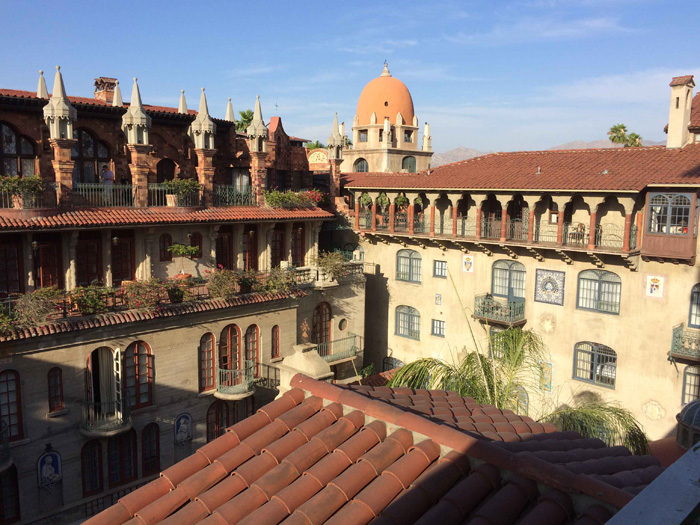
High atop the Spanish Wing is Author's Row with its arched openings. Many celebrated authors stayed for months at a time in these premier rooms.
The third portion of the Inn is the Spanish Wing, designed by Myron Hunt and filled with high arches that are cut into enormous walls of poured concrete. Below at the ground level is the Spanish Patio, an alfresco dining space that is part of the Inn's main dining room and overlooked by a clock tower. We stroll past a series of rooms known as "Author's Row," fashioned of unique terra cotta blocks. From here a small pedestrian bridge spans Sixth Street to an annex, originally built as a dormitory for employees.
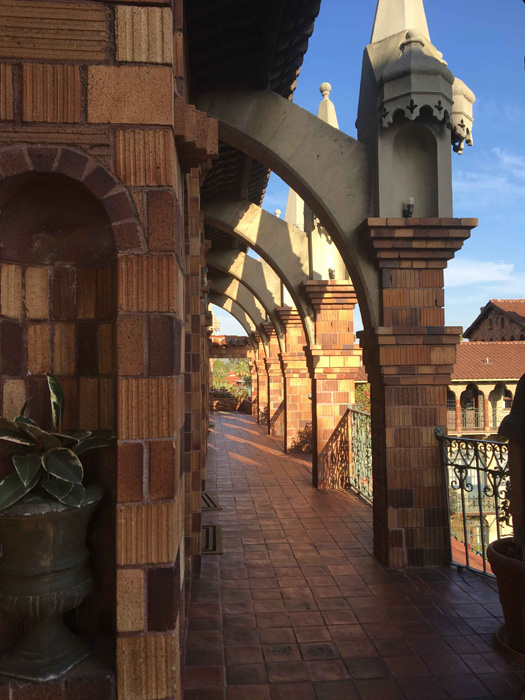
Flying buttresses were incorporated into the elaborate Spanish Wing by architect Myron Hunt.
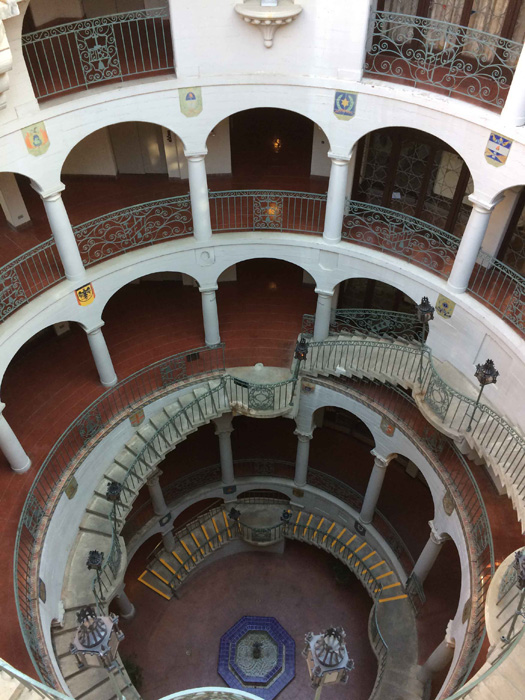
Designed by architect G. Stanley Wilson, the International Rotunda Wing is distinguished
by a six-story cylindrical staircase that spirals down to the ground level.
The bridge marks the beginning of the Inn's fourth and final wing, The International Rotunda. This extraordinary space was designed by Riverside architect G. Stanley Wilson. The name comes from its signature feature, a six-story high cylindrical court that measures 33 feet across, with stairs that spiral to the ground level. "Oh, wow!" gasps my husband as we turn toward a majestic gold, blue and white tower known as Amistad, or Friendship Tower. This massive structure surmounts the arch-covered sidewalk below. The Rotunda wing is also distinguished by walls flecked with colorful tiles and grillwork atop arched windows and round balconies.
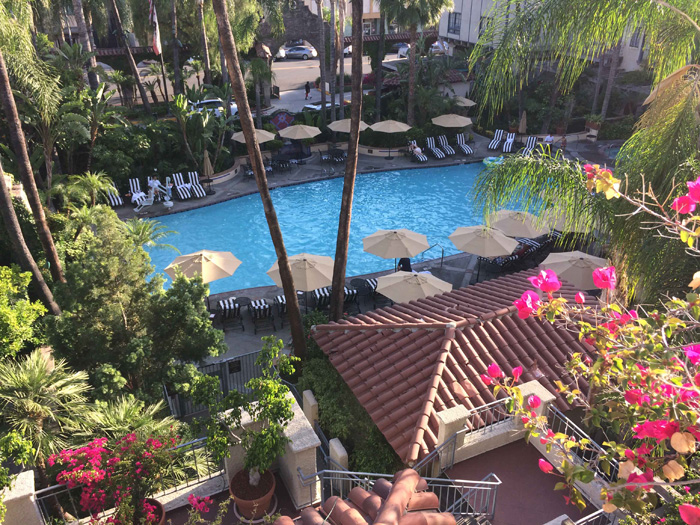
Viewed from above, the Inn's enormous swimming pool shimmers through palm fronds.
"What a great place to play hide and seek!" I remark as three
small children dart past us, giggling with delight. We linger on the rooftop
for another hour, discovering hidden nooks, stained glass windows, wall
medallions, even a row of flying buttresses where a model is posing for
a photographer. Fronting the property below us is the Court of the Birds
and a vine-covered pergola. A huge swimming pool shimmers through palm
fronds. "Now that is one pool paradise," says my husband. A
room in Author's Row is open and we peer in. It is at least three times
as large as ours with soaring ceilings and a generous seating area. "This
room probably rents for $1200 a night," I venture a guess. Atop the
Cloister Wing is a secluded area dominated by the Carmel Dome and its
orange roof. Apparently the dome once had portholes and telescopes through
which guests could peer at the heavens. Nearby, an exclusive rooftop compound
is reserved for visiting dignitaries and business moguls. "Frank
Miller was definitely into architecture!" my husband declares, completely
bowled over. Indeed, "The Master of the Inn" believed that "while
music is wonderful and painting appeals to us greatly, architecture lives
on forever." The world of celebrities agreed with him, and during
his lifetime they came by the hundreds. Among the Inn's aficionados were
Sarah Bernhardt, Will Rogers, Booker T. Washington, Clark Gable, Judy
Garland, Amelia Earhart, Charles Lindbergh, John Glenn, John D. Rockefeller,
Albert Einstein and Harry Houdini. One unexpected guest was a circus elephant
who broke away from a nearby railroad car and invaded the grounds. "He
was the only guest who was allowed to carry his own trunk," said
a smiling Miller at the time of the incident. European royals also came
in droves. Accordingly, lavish formal galas became regular events at the
Inn, each one showcasing the staff's ingenuity and dedication.
The Inn's glory days lasted well into the 20th century, but upon Frank Miller's death in 1935, the property fell into steady decline. "His daughter, Allis, and son-in-law, DeWitt, struggled to keep the property afloat during the depths of the Great Depression, but Easterners were no longer coming out for extended stays," says the knowledgeable concierge in the lobby area whom we asked to fill us in on the Inn's history. "Business improved a little during the World War II, but when Allis and DeWitt passed on, the Inn entered a 20-year-period of turmoil and bankruptcies." Apparently, the city finally had to step in, having decided that The Mission Inn was a valuable part of its history and identity, ushering in an era of public ownership and a few restoration projects. "But the difficulties continued and finally a private firm purchased the distressed property for only $3 million," she adds. By 1988, after four years of systemic upgrading and remodeling, the firm had exhausted its supply of cash and credit and ownership of The Mission Inn reverted to the firm's main creditor, the Chemical Bank of New York. It took four more years for a buyer to emerge. "In 1992 Duane and Kelly Roberts, Riverside residents and owners of the privately held Entrepreneurial Capital Group, stepped in," the concierge explains.
Duane and Kelly, known as "the Keepers of the Inn," have poured lots of love and treasure into a top-to-bottom restoration of the entire structure as well as an upgrading of the grounds and restaurants. "The hotel needed extensive repairs, modernization and fumigation," the concierge continues. "At one point the complex had to be tented and the Mission Inn was listed in the Guinness Book of Records for having been covered by the world's largest termite fumigation tent!" The couple, Riverside residents who made millions in the frozen foods industry, continue to improve the property, making valuable additions throughout. In 1995 they launched the Inn's annual "Festival of Lights," a six-week period beginning after Thanksgiving when the hotel and grounds are festooned with three million lights and animatronic figures. It is the largest holiday light show in the country and the Inn's busiest time of year, with rooms nearly impossible to be had and the entire city of Riverside teeming with tourists.
"We
are also the number one wedding venue in California!" the concierge
brags. "I hope you'll get a chance to see our two wedding chapels.
But they are nearly always booked at which time they are off limits. However,
you can admire their exteriors from afar and you can see photos of the
interiors," she adds. "In the St. Francis chapel there is a
gold leaf altar from Guanajuato, Mexico and seven stained glass windows
by Louis Comfort Tiffany. I recommend that you sign up for a docent tour
on your last morning. You will get to see several magnificent interior
rooms and other spaces that are not open to the public."
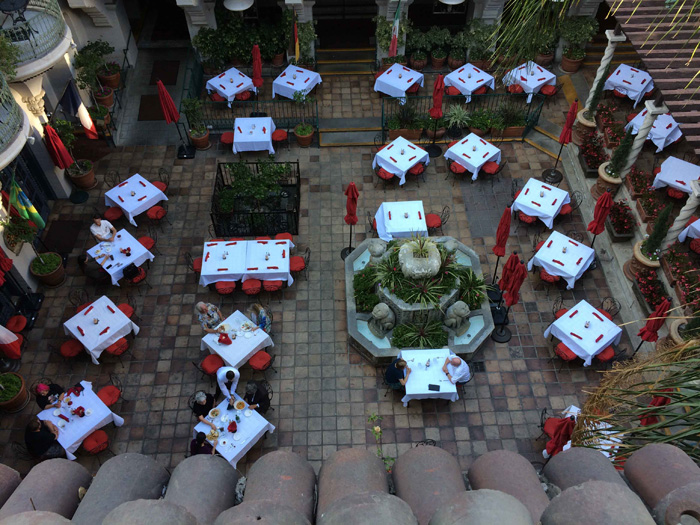
The Spanish Patio is distinguished by vintage tiles imported from Cordoba and a circular fountain with water spouting gargoyles.
It is the eve of the Fourth of July and we are anxious to dine at the Inn's Spanish Patio. "Check it out! So European!" exclaims my husband as he surveys its patio walls festooned with tiny bells and a floor paved with imported terra cotta tiles. The Patio is part of the main Mission Inn Restaurant, expressly designed to inject a touch of Spain with its central fountain featuring four water-spouting gargoyles. The patio is dominated by the two-story Anton Clock Tower from which five rotating figures are supposed to emerge every 15 minutes. "The clock is in disrepair at this time. But they're working on it," explains our waiter. "Can you tell us about the figures?" I ask. He is both knowledgeable and proud, breaking into a huge smile. "Well, there is Father Junipero Serra, Juan Bautista de Anza, St. Francis, of course, a California grizzly bear and a native Indian from these parts. The Tower is a copy of the one in Nuremberg, Germany." We order a light dinner and sit back and relax. "Before you leave, do walk over to the wall where Miller's favorite biblical quote is inscribed," the waiter suggests. "Where there is no vision, the people perish," proclaims the old adage. By now I am totally convinced that we would have gotten along well with Miller, with whom we share both our name and a passion for collecting art. "What an amazing day!" I sigh as I put my head down on the pillow, the Inn's dizzying array of art and architecture becoming a blur.
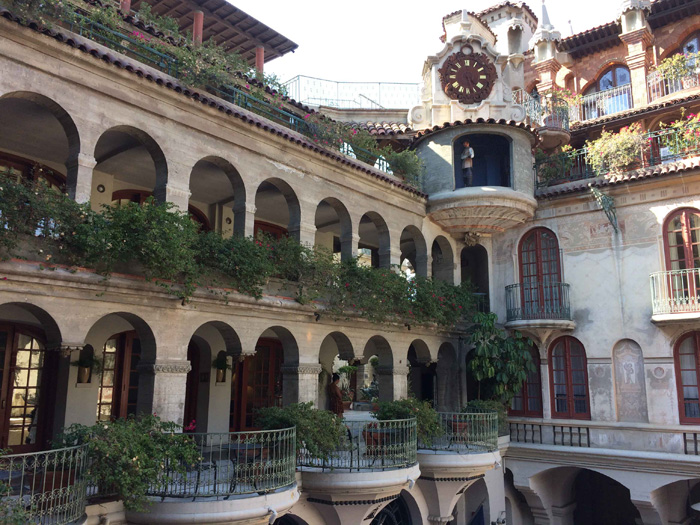
The Anton Clock Tower, a copy of a historic clock in Nuremberg, Germany, features five figures timed to emerge every 15 minutes.
The Spanish Patio opens its doors for breakfast at 9 AM. We make a beeline
for a quiet spot under an umbrella. I am amazed by how moderately priced
the menu is, unlike breakfast fare at most hotels. My eggs are divine
and the Applewood cured bacon crisped to perfection, while my husband's
fresh lox and bagels are loaded with sides. An attentive waiter keeps
refilling our cups with steaming coffee. Nothing is left to chance. "Someone
is doing something right in the kitchen." I remark. Then I remember
having read that when Kelly Roberts took over as the COO, she made the
upgrading of the Inn's restaurants her number one priority. "How
about if we head into the town," my husband suggests.
Riverside's
streets are eerily quiet on the Fourth, its residents at home readying
for their holiday BBQs. With virtually no traffic, it's easy to whiz down
Market Street which turns into Magnolia Avenue. The concierge on the morning
shift had given us a small map, assuring us that a few antique stores
will be open. "But you should also drive around," she suggested.
"There are some examples of Beaux Arts, Mission Revival, Norman Gothic
and even Queen Anne architecture. If you have time, wind up to the top
of Mount Rubidoux. Frank Miller bought the site in 1906, erected a large
cross, and launched the country's very first outdoor Easter service there."
We zip down Magnolia Avenue, having the road virtually to ourselves. The
town is definitely an eclectic trove of architecture: bungalows, old Victorians,
some mid-century ranches, even old adobe houses that have been remodeled.
Near the corner of Elizabeth Street, Forget-Me-Not Antiques displays an
open sign. It's a charming shop, neatly organized and loaded with farmhouse
relics, the kind of items that Joanna Gaines of "Fixer Upper"
would snap up in a minute. Back on Market Street, Cadillac District Antiques
is also open. The proprietors have amassed a sizeable stash of European
and American furniture. I am surprised to learn they are immigrants from
Ethiopia and grateful to be living in America. We walk out with a vintage
cachepot, perfect for our fireplace hearth.
"Let's walk around the perimeter of the Inn," I suggest when
we return to the hotel parking. The property covers more than two and
a half acres, with elevations varying from one to six stories. We begin
by heading east along Mission Inn Avenue lined with brick walls and massive
stucco arches. Embedded in the bricks are weathered crests and carved
heads. We turn left on Orange Street and stroll past four floors of rooms
built during the Inn's first phase. Raincross light standards, the Inn's
signature emblem, tower above us and iron grilles shield small gardens.
A fabric canopy covers the Orange Street entrance to the hotel. Here the
Cloister Wing begins with its distinctive leaded glass windows. Four flying
buttresses arch over the sidewalk and some of the rooms here have stained
glass windows and balconies. "How often does one run into buttresses?"
chuckles my husband. We turn onto Sixth Street where the Inn transitions
into the Spanish Wing with its high-arched windows. Inside is the two-story
Spanish Art Gallery which we hope to visit on our docent tour. I pause
under the bridge that leads to the Annex to admire colorful ceramic tiles
with images of Christopher Columbus and Queen Isabella, a nod to the history
of Spain. We've now merged into the International Rotunda Wing with its
covered sidewalk. High above us is the now-familiar Amistad Dome. At the
corner of this wing is Bella Trattoria, featuring authentic Southern Italian
cuisine. Next door Casey's Cupcakes is the hotel's popular sweet shop,
famed for its confections, wedding cakes and unusual ice cream flavors.
A narrow corridor leads back toward the entrance, past Kelly's popular
Tuscan Spa. Inside, the mosaic-tiled space is a temple of indulgent pampering.
Near the Spa, a small statue of St. Francis of Assisi, patron saint of
the Inn, depicts him with his beloved birds. Continuing under a vine covered
pergola we find ourselves back at the front entrance. "I think we've
finally gotten a grasp of this place!" I sigh.
Two hours later we are back at Bella Trattoria. Wonderful aromas emanate from the wood-burning oven inside. A placard on the sidewalk advertises the special of the day: wild-caught red trout served on a bed of saffron asparagus risotto. "Sounds incredible," says my husband who is a big fan of trout. "Our portions are really huge," advises the waiter. "You could easily share a salad and the trout." The meal is beyond fabulous! Next to us two families with young children are enjoying thin-crusted pizzas and house-made pasta. "Ciao," I wave as we leave, planning to return on our next trip. The evening light is soft as we stroll past the Mission Inn Museum, closed now, but where we will begin our docent tour tomorrow. Back in the lobby, we sink into a couch and watch the comings and goings. Two local ladies seated across have just emerged from the Spa and are raving about their treatments. I make a mental note to try it out on our next visit. Around nine in the evening, we ascend to the rooftop, now overrun with hotel guests. In the distance colorful fireworks are exploding over Mount Rubidoux. "Have you ever seen so many people just hanging out on a roof?" asks a hotel guest as she pushes her way back to the elevator.
"The
first available docent tour is at 10:15," says the morning concierge.
We squeeze in another delicious breakfast at The Spanish Patio, then rush
toward the Mission Inn Museum where the tour is about to begin. Operated
by the non-profit Mission Inn Foundation, it houses changing exhibits
featuring memorabilia and art treasures from the Inn's vast holdings.
A small group has gathered around a scale model of the property where
Ron McCaskill, the morning docent, is about to begin the tour. "The
Inn is only one of three hotels in California that is a National Historic
Landmark," he notes. "It is the largest example of Mission Revival
architecture in the country." Ron explains that the original 65-room
Glenwood Mission Hotel was eventually razed and replaced by the swimming
pool we see today. We trail behind him under the pergola toward an oversized
bronze statue of Frank Miller holding Joseph, one of his pet macaws. "The
name Joseph comes from the biblical Joseph and his coat of many colors,"
Ron clarifies. He leads us back to the Nanking Bell. "When Louis
Comfort Tiffany came here in 1915, he wanted to buy it because it was
the largest in Miller's collection of 800 bells. When he was refused,
he left in a hissy fit." Inside the lobby area is another of Miller's
prized bells, the oldest one in Christendom, purchased in England for
the sum of $25. "In those days $25 was a good amount of money,"
says Ron.
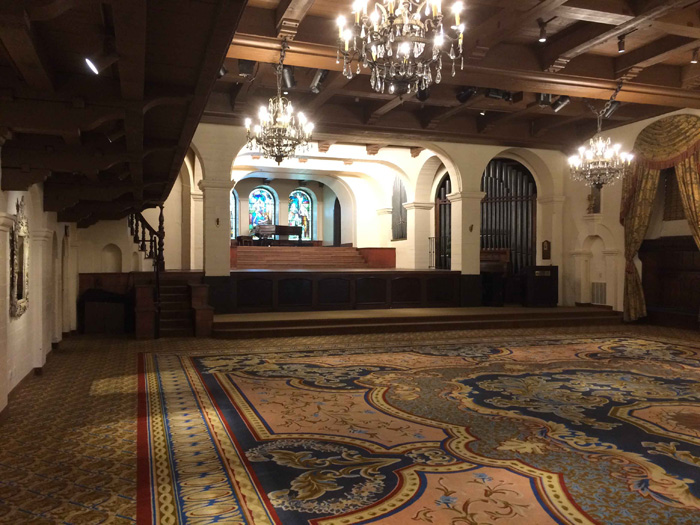
The Inn's enormous Music Room once served as a ballroom and concert hall. A Kimball Arts and Crafts pipe organ sits to the side of three stained glass windows dedicated to Saint Cecilia.
Docent Ron heads to the Cloister Wing, where stairs descend to the Music Room, an enormous space that was once the Inn's grand concert hall and ballroom, today its prime conference space. A large Kimball Arts and Crafts pipe organ sits to the side of three stained glass windows dedicated to Cecilia, the patron saint of music. "Every organist in the country wanted to play on this magnificent organ," Ron notes, "including the one from the Norman Tabernacle Choir." We pause on a landing overlooking the Glenwood Bar, originally built to service special events in the ballroom. Ron leads us to the 1914 Spanish Wing and its enormous art gallery hung with an eclectic assortment of European paintings. These days the space is used for wedding receptions and galas. Miller's art treasures were culled from all over the world which he crisscrossed for 30 years, shipping back thousands of pieces. Many of these items, including a large collection of pianos, were stored in a subterranean network of tunnels known as "the catacombs." Dozens of urban legends have cropped over the years about the catacombs which are closed to the public today. "Some people claim they are haunted," Ron adds with a sly smile. Miller also developed an appreciation for Asian culture and created appropriate spaces to house its art. We enter the outdoor Court of the Orient and the Ho O Kan Room where a giant gilded Buddha from the 1800s dominates the space. Today both areas service wedding receptions and private parties. "Speaking of weddings, unfortunately, we can't see the St. Francis Chapel today because there is a wedding taking place as we speak," Ron explains. "But we'll pause by the Atrio Courtyard and you can take a photo of the exterior and also of a second wedding chapel, St. Cecilia's, off to the side." I make a mental note to be sure to take another docent tour on our next visit. "Each one is different," the concierge had told us. "Maybe we'll get lucky and even catch the chapel between weddings," I mutter to myself.
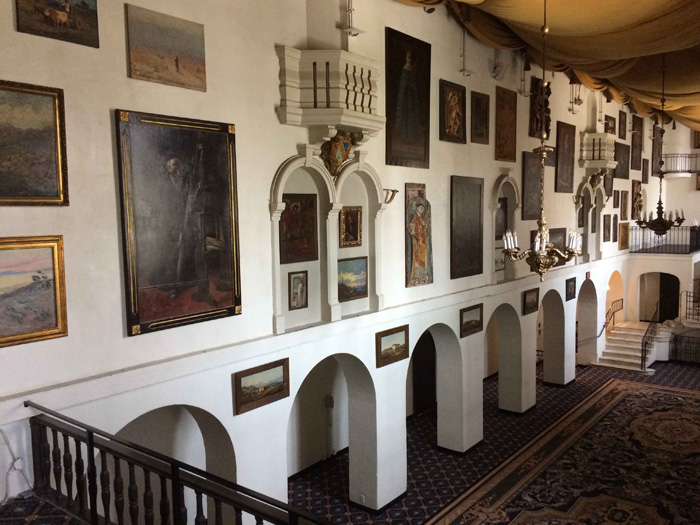
The Spanish Gallery, a magnificent two-story room, is hung with an eclectic collection of European paintings. Today, the space hosts wedding receptions and formal galas.
"How did you enjoy your stay?" queries the receptionist when we ask for our bill. "More than we could ever begin to tell you," I respond. As the valet delivers our car I suddenly realize we forgot to take an orange from the overflowing bowl atop the reception desk. I had been eyeing those luscious oranges ever since we arrived. "Not to worry," says my husband. "That means we will definitely be back!"
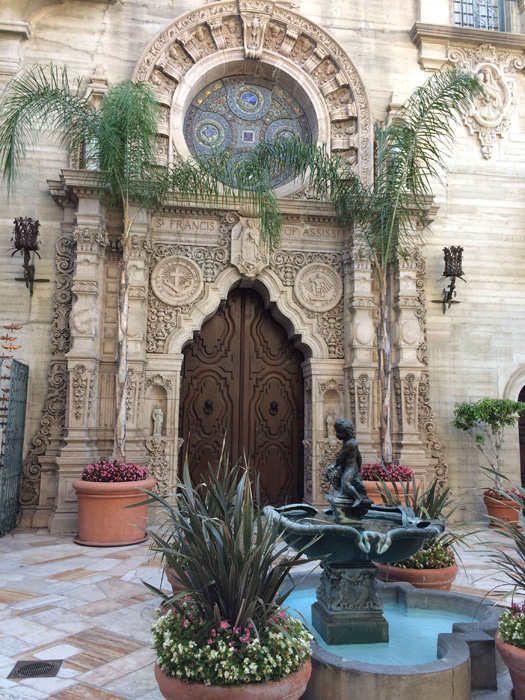
The St. Francis Chapel is California's number one wedding site. Inside, it features a magnificent
gilded altar from Guanajuato, Mexico and stained glass windows by Louis Comfort Tiffany.
